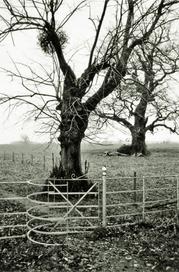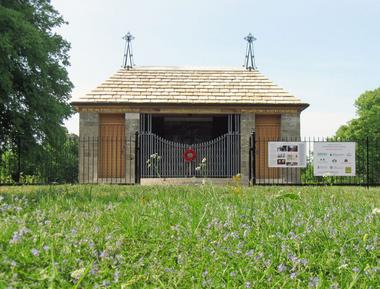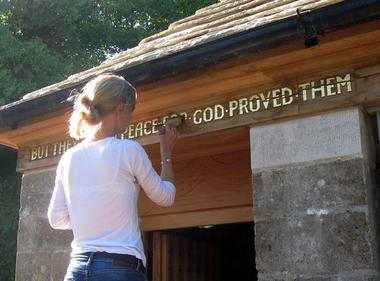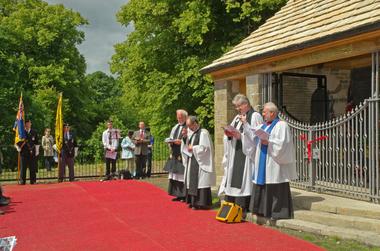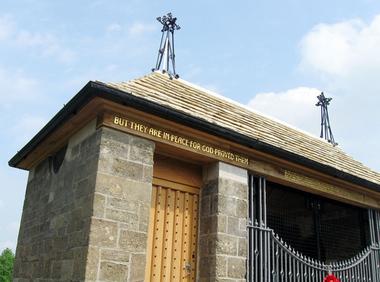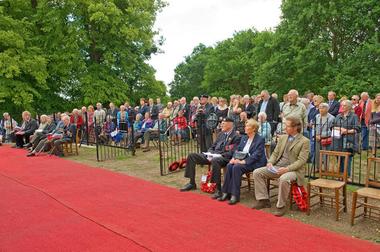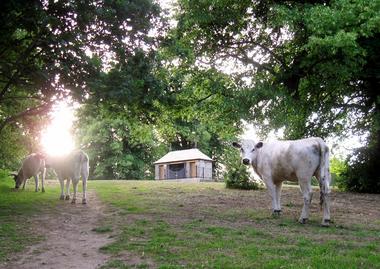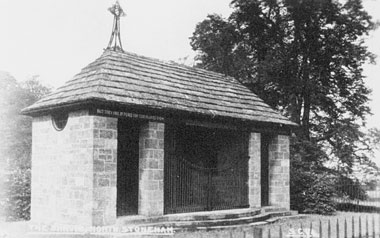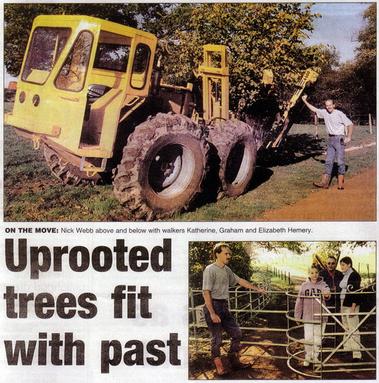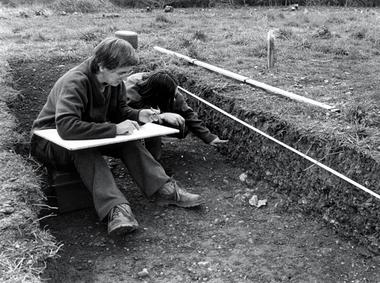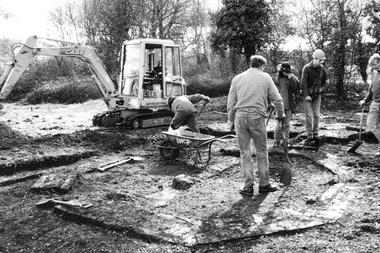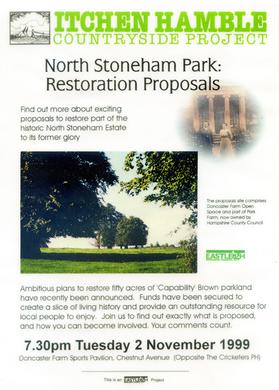 |
|
|
|
|
|
"Capability Brown was possibly the most significant landscape designer of all time. His achievements read like a list of our finest stately homes, and to have some of his work on our doorstep is indeed a great privilege. However, to local people, the North Stoneham Estate offers much more than a prime example of eighteenth century landscape design. To them, Stoneham is important for different reasons. The overwhelming response to a recent request for information in the Borough News, is indicative of great importance that local people attach to this land."
-Cllr. W Luffman and Cllr P Wall, joint chairs, Eastleigh Area Committee, 1999 |
|
|
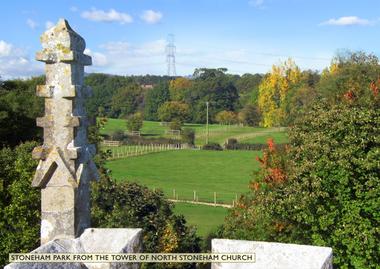
Restoration of Shrine completed
Published by on June 6, 2011
On 6 May 2011, with the carved lintels gilded with gold leaf by Emily Willis Fleming, the restoration of the Stoneham War Shrine was completed. The Shrine was rededicated at a special service and act of remembrance on 22 May 2011. Following the Service, the Stoneham Spring Fayre was held there and the cows were welcomed into the Park.
Heritage Lottery Fund rescues Stoneham War Shrine
Published by on August 20, 2008
The Shrine then 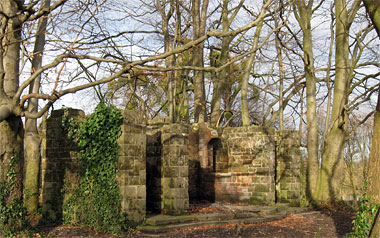 The Shrine now (2008) A remarkable WW1 War Shrine at North Stoneham, near Eastleigh in Hampshire is to be restored thanks to a grant from the Heritage Lottery Fund (HLF). The award of 50,000 will enable Eastleigh Borough Council and the Willis Fleming Historical Trust to return the shrine to its original condition, to further the conservation of the historic parkland where the monument stands, and undertake a linked series of public events. The War Shrine was built in 1917 by landowner John Willis Fleming in memory of his son Richard and the other thirty-six men of North Stoneham parish who had died in the Great War. The shrine was built in historic North Stoneham Park, a 1000-acre parkland designed by 'Capability' Brown in the eighteenth century. The shrine's present ruinous condition reflects the great changes to the North Stoneham area over the last half century. The year-long project will begin this November with a special ceremony at the shrine on Remembrance Sunday. The main restoration work is expected to take place next spring. The shrine is one of an identical pair, the other was built at Havenstreet on the Isle of Wight. Both used stone from Isle of Wight quarries owned by the Fleming family. The Havenstreet Shrine was restored in the 1960s. Landscape improvements will reinstate the North Stoneham shrine as a focal landmark within Avenue Park, and help make the park more accessible to the public. The monument's renewal will go hand in hand with an act of community remembrance, using the shrine as a key to unlocking the wider history of the local landscape - through a programme of public events, including special activities for schools. Mark Miller of Eastleigh Borough Council said: "This is a very exciting project that will allow current and future generations to understand and appreciate an important aspect of local history." Harry Willis Fleming of the Willis Fleming Historical Trust, said: "This is fantastic news, and a real endorsement that this neglected heritage is special and worth safeguarding for the future." Commenting for the Heritage Lottery Fund, Head of HLF South East England Michelle Davies said: "This is an unusual example of this type of memorial and its restoration will encourage the public to discover more about its origins while enhancing the historic landscape of which it is a part." The project is also supported by Eastleigh Local Area Committee- which has contributed 25,000 - Hampshire County Council and the Hampshire Gardens Trust. Additional funding is being sought from other sources and from individual giving. There is an opportunity to visit the shrine in its derelict state when Avenue Park with St Nicolas Church is opened on 13-14th September as part of the national Heritage Open Days scheme.
English Heritage recommend the compilation of a conservation plan
Published by on February 18, 2002
English Heritage recommended that "the compilation of a conservation plan for the site would be an extremely advantageous exercise, which English Heritage would highly recommend. It is generally acknowledged that conservation plans are invaluable tools in the restoration and subsequent maintenance of historic sites such as North Stoneham Park. Such a work would address systematically the historic development of the whole site, including the areas in disparate ownership. "Having produced an historic survey, the information could be used to address the conservation and maintenance of both the buildings and the landscape. In doing so, the areas of most and least historic sensitivity within the site would be highlighted in an objective manner, this process being informed by the historic survey. The result of this would be the production of a prioritised list of targets for the maintenance and restoration of the landscape, based on the results of the historic survey. The benefit of this would be that the landscape could receive attention in an informed and systematic manner, ensuring that restoration and maintenance activities could be programmed to enhance the landscape in the most appropriate way. It would also prove useful, should the requirement arise for further development on the site, in helping to identify in an objective manner the possible areas which might least compromise the historic character of the site."
Uprooted trees fit with the past
Published by on December 4, 2001
From the Southern Daily Echo: "Thirty lime trees standing in the way of an ambitious two year project to restore the remains of historic parkland at North Stoneham to its former glory have been uprooted. Research showed that the trees at Avenue Park would not have featured in the original plans of the site by famous 18th century landscape garden designer Capability Brown. But instead of axing them, The Itchen Hamble Countryside Project merely moved the limes to a new location and realigned them with the remains of a lime avenue believed to fit in with Brown's original design. Countryside projects officer Nick Webb explained: "With the help of an ingenious piece of machinery known as a tree spade. the trees were moved quickly and efficiently to provide an instant impact upon the landscape." The countryside project, based in Eastleigh council's countryside and recreation services department, has also restored a section of old carriage drive, complete with a traditional metal kissing gate. The drive originally connected Chestnut Avenue to the former North Stoneham House. Other recent works include the planting of several specimen oaks with practical and financial assistance from the Hampshire branch of the International Tree Foundation. The huge restoration project of the vital green lung on Eastleigh's southern boundary with Southampton has been made possible through a partnership of Eastleigh council with local people, Hampshire County Council, Eastleigh and District Angling Club and other local landowners. Cash for the scheme has primarily come from developers' contributions following redevelopment of the Stoneham Rectory site several years ago with further financial, design and practical assistance from the county council." Time travellers reveal North Stoneham's hidden past
Published by on March 2, 2000
Volunteers helping with the restoration of Avenue Park, North Stoneham, have stepped back hundreds of years in time. Working alongside professional archaeologist Christopher Currie, they have revealed the footprint of a pair of lodge houses marking the entrance to a once magnificent country estate. And further excavations have unearthed a drive once plied by horse-drawn carriages, forming part of 'Capability' Brown's original design for the park. The North Stoneham Estate, just outside Eastleigh, Hampshire, originally extended to more than 400 acres, and was the country seat of the Fleming family. Although the old mansion has long since been demolished, much of the parkland survives and is now the focus for a major restoration project, being led by Eastleigh Borough Council. The parkland itself dates to 1599, but was remodelled in the eighteenth century by Lancelot 'Capability' Brown, famous for his pioneering work at many of England's finest stately homes. With few records of the parkland remaining - none of Brown's original plans survive - archaeology is being used as a valuable tool, guiding the restoration process and bringing to life the rich history of the site. James Watson of Eastleigh Borough Council's Itchen Hamble Countryside Project said, 'Recent archaeological excavations have confirmed that the Winchester Lodge must have been an imposing building, befitting of the entrance to a fine country estate. In fact, there were two lodge houses, one each side of the drive, separated by a huge pair of iron gates and substantial brick pillars. These octagonal buildings were faced in a high quality brick, adding to the illusion of grandeur'. However, the buildings would have provided only basic accommodation by modern standards, with each lodge measuring barely ten feet across, and living and sleeping quarters provided in separate buildings. Restoration of Avenue Park is being taken forward by Eastleigh Borough Council, working in close partnership with Hampshire County Council, private landowners and volunteers. The landscape will be restored close to 'Capability' Brown's original vision, providing a valuable resource for all local people to enjoy.
Forgotten landscape to be restored
Published by on December 20, 1999
Ambitious plans to restore a forgotten landscape on the edge of Eastleigh have been given the green light. At a recent meeting of the Eastleigh Local Area Committee, Borough Councillors voted unanimously to support detailed proposals brought forward by countryside officers - a decision which has been endorsed by local people at a recent public meeting. Work can now begin on the major task of returning part of the historic North Stoneham Park to its former glory, as originally conceived by the celebrated eighteenth-century garden designer, Lancelot 'Capability' Brown. More than two centuries after his death, Brown is regarded as one of the greatest landscape designers of all time. Few people can have made such an important and lasting contribution to the English landscape. Gardens at Longleat, Petworth, Chatsworth, Bowood and Blenheim are among his most significant achievements. The restoration of Avenue Park will be undertaken by the Itchen Hamble Countryside Project, part of Eastleigh Borough Council, working in partnership with Hampshire County Council, landowners and local people. Work will be funded primarily through a Section 106 Planning Agreement, following redevelopment of the Stoneham Rectory site, three years ago. Though many of the original features of the North Stoneham Estate have now gone - the old house was demolished in 1939 -much of the parkland remains intact and bears many of the hallmarks of Capability Brown's work, typified by a gently rolling landscape with informal clumps of parkland trees. Brown rejected the formal landscapes of his predecessors, typifying eighteenth-century ideals of our relationship with nature. At Stoneham, he removed formal tree-lined drives and introduced new planting and ponds to create a more natural landscape. The current proposals seek to restore the landscape close to Brown's original vision. The proposals include clearing back scrub and brambles, planting trees, and installing traditional park fencing and kissing gates. A footpath following the line of the original entrance drive from Chestnut Avenue will also be created, enticing people into the centre of the park. A heritage trail will bring to life the rich history of the estate. Support of landscape restoration by Eastleigh Area Committee
Published by on December 20, 1999
"This is an extremely exciting project. Capability Brown was possibly the most significant landscape designer of all time. His achievements read like a list of our finest stately homes, and to have some of his work on our doorstep is indeed a great privilege. However, to local people, the North Stoneham Estate offers much more than a prime example of eighteenth century landscape design. To them, Stoneham is important for different reasons. The overwhelming response to a recent request for information in the Borough News, is indicative of great importance that local people attach to this land. Childhood memories of a magnificent country estate have not faded with time. With their help, our officers have been piecing together a unique picture of what this area used to be like. We believe that Avenue Park can be restored as a slice of living history, providing an outstanding resource for all local people to enjoy, and a place where wildlife can flourish. Our committee commends these proposals. We urge you to give them your full support." Cllr. W Luffman and Cllr P Wall, joint chairs, Eastleigh Area Committee, 1999 County Planning Officer implements Management Framework for North Stoneham
Published by on July 6, 1993
Archaeologist C K Currie's report for HCC
Published by on April 30, 1992
North Stoneham Park: its origin and development. Christopher K. Currie, Research Fellow, Gardens Archaeology Project. Fieldwork and research undertaken for the Planning Department, Hampshire County Council, April 1992. This report looks at the earliest origins of the deer park at North Stoneham. It traces how the park was accommodated into an already existing landscape, dating back to the Saxon period. There are also traces of Roman features within this landscape that may have also influenced its development. Clues to the early landscape are given in a charter of A. D. 932 for North Stoneham. Support for inferences drawn from this document are given in other Saxon charters for neighbouring estates. These, together with cartographic and topological evidence, indicate that North Stoneham Common had been created as an area of common pasture by at least the middle Saxon period. An old trackway can be traced between the common and a farmstead apparently referred to on one of the charters. A Roman building on the site of this farmstead hints at earlier origins. This trackway was later used as the southern boundary of the medieval deer park. The boundaries of the deer park are traced by fieldwork. These seem to be confirmed by documentary evidence from the sixteenth century as encompassing an area of about 32 hectares (80 acres). The development of the park is traced to the present day, and indicates that it was considerably expanded by the Fleming family after 1599. This expansion continued throughout the eighteenth and early nineteenth centuries. The evidence for a possible 2,000-year continuity of elements within the landscape at North Stoneham is not common in the United Kingdom. Although this landscape has been considerably damaged in the recent past by development, there is still a good case for conservation of the remaining areas. The ability to demonstrate long-term landscape survival and evolution as an educational resource could prove to be valuable, and protection of certain elements in this landscape is recommended. Chris Blandford Associates produce landscape survey and management proposals
Published by on April 30, 1991
'North Stoneham Park Historic Landscape Survey and Outline Proposals for Future Management (1991)' by Chris Blandford Associates.
[Extracts will added shortly]
|
|
